| Skip Navigation Links | |
| Exit Print View | |

|
Using Database Operations with Oracle Java CAPS Database Adapters Java CAPS Documentation |
| Skip Navigation Links | |
| Exit Print View | |

|
Using Database Operations with Oracle Java CAPS Database Adapters Java CAPS Documentation |
DB2 Database Operations (BPEL)
Manipulating the ResultSet and Update Count Returned by Stored Procedure
Collaboration Usability for a Stored Procedure ResultSet
DB2 Connect Adapter Database Operations (BPEL)
DB2 Connect Adapter Database Operations (JCD)
Manipulating the ResultSet and Update Count Returned by Stored Procedure
Collaboration Usability for a Stored Procedure ResultSet
JDBC Adapter Database Operations (BPEL)
JDBC Adapter Database Operations (JCD)
Manipulating the ResultSet and Update Count Returned by Stored Procedure
Collaboration Usability for a Stored Procedure ResultSet
Oracle Adapter Database Operations (BPEL)
Oracle Adapter Outbound XA Support for BPEL
Oracle Adapter Database Operations (JCD)
Manipulating the ResultSet and Update Count Returned by Stored Procedure
Collaboration Usability for a Stored Procedure ResultSet
Long RAW for Prepared Statements and Stored Procedure Support
SQL Server Adapter Database Operations (BPEL)
SQL Server Adapter Database Operations (JCD)
Manipulating the ResultSet and Update Count Returned by Stored Procedure
Sybase Adapter Database Operations (BPEL)
Sybase Adapter Database Operations (JCD)
To Perform a Query Operation on a Table
To Perform an Insert Operation on a Table
To Perform an Update Operation on a Table
To Perform a Delete Operation on a Table
Manipulating the ResultSet and Update Count Returned by Stored Procedure
Collaboration Usability for a Stored Procedure ResultSet
VSAM Adapter Database Operations (BPEL)
The database operations used in the Oracle Adapter are used to access the Oracle database. Database operations are either accessed through activities in BPEL, or through methods called from a JCD Collaboration.
The Oracle Adapter uses a number operations to query the Oracle database. Within a BPEL business process, the Oracle Adapter uses BPEL activities to perform basic outbound database operations, including:
Insert
Update
Delete
SelectOne
SelectMultiple
SelectAll
In addition to these outbound operations, the Oracle Adapter also employs the inbound activity ReceiveOne within a Prepared Statement OTD.
The Business Rules Designer includes Input and Output columns to map and transform data between activities displayed on the Business Process Canvas.
Figure 1-4 displays the business rules between the FileClient.write and otdOracle.Db_employeeDelete activities. In this example, the whereClause attributes appears on the Input side.
Figure 1-4 Input and Output Between Activities
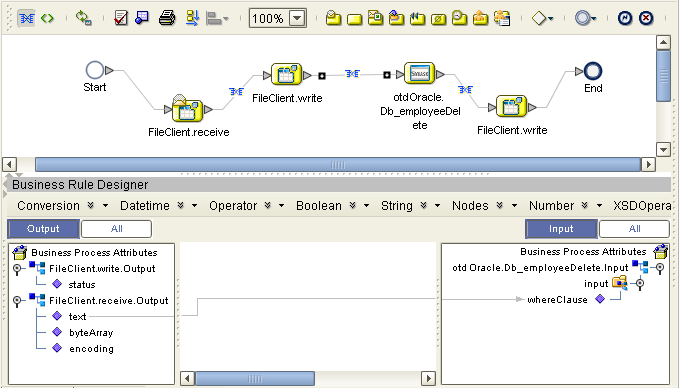
The following table lists the expected Input and Output of each database operation activity.
Table 1-4 Oracle Operations
|
There are a few additional steps required to enable Business Processes for XA support when using the Oracle Adapter.
Figure 1-5 Business Process Properties
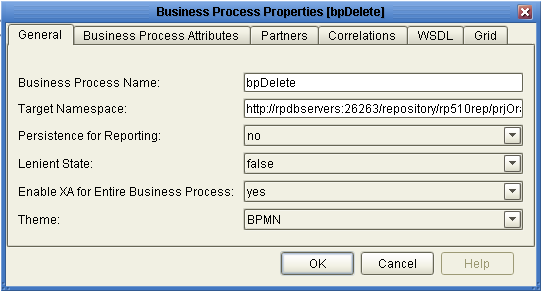
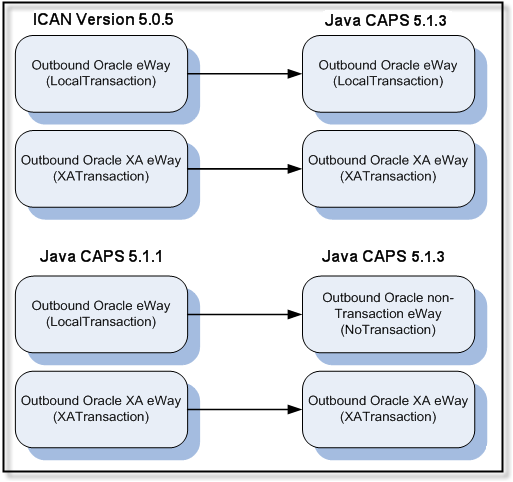
The same database operations are also used in the JCD, but appear as methods to call from the Collaboration. Tables, Views, and Stored Procedures are manipulated through OTDs. Methods to call include:
insert()
insertRow()
update(String sWhere)
updateRow()
delete(String sWhere)
deleteRow()
select(String where)
Note - Refer to the Javadoc for a full description of methods included in the Oracle Adapter.
A table OTD represents a database table. It consists of fields and methods. Fields correspond to the columns of a table while methods are the operations that you can apply to the OTD. This allows you to perform query, update, insert, and delete SQL operations in a table.
By default, the Table OTD has UpdatableConcurrency and ScrollTypeForwardOnly. The type of result returned by the select() method can be specified using:
SetConcurrencytoUpdatable
SetConcurrencytoReadOnly
SetScrollTypetoForwardOnly
SetScrollTypetoScrollSensitive
SetScrollTypetoInsensitive
Note - The content of the input.getText() file may contain null, meaning it will not have a where clause or it can contain a where clause such as empno > 50.
For example:
package prjOracle_JCDjcdALL;
public class jcdTableSelect
{
public com.stc.codegen.logger.Logger logger;
public com.stc.codegen.alerter.Alerter alerter;
public com.stc.codegen.util.CollaborationContext collabContext;
public com.stc.codegen.util.TypeConverter typeConverter;
public void receive( com.stc.connector.appconn.file.FileTextMessage
input, dtd.otdOutputDTD1325973702.DB_Employee otdOutputDTD_DB_Employee_1,
otdOracle.OtdOracleOTD otdOracle_1, com.stc.connector.appconn.file.
FileApplication FileClient_1 )
throws Throwable
{
FileClient_1.setText( "Selectiong records from db_employee table via
Table Select........" );
FileClient_1.write();
otdOracle_1.getDb_employee().select( input.getText() );
while (otdOracle_1.getDb_employee().next()) {
otdOutputDTD_DB_Employee_1.setEmpNo( typeConverter.shortToString(
otdOracle_1.getDb_employee().getEMP_NO(), "#", false, "" ) );
otdOutputDTD_DB_Employee_1.setLastname( otdOracle_1.getDb_employee().
getLAST_NAME() );
otdOutputDTD_DB_Employee_1.setFirstname( otdOracle_1.getDb_employee().
getFIRST_NAME() );
otdOutputDTD_DB_Employee_1.setRate( otdOracle_1.getDb_employee().
getRATE().toString() );
otdOutputDTD_DB_Employee_1.setLastDate( typeConverter.dateToString(
otdOracle_1.getDb_employee().getLAST_UPDATE(), "yyyy-MM-dd hh:mm:ss", false, "" ) );
FileClient_1.setText( otdOutputDTD_DB_Employee_1.marshalToString() );
FileClient_1.write();
}
FileClient_1.setText( "Table Select Done." );
FileClient_1.write();
}
}This example inserts an employee record.
package prjOracle_JCDjcdALL;
public class jcdInsert
{
public com.stc.codegen.logger.Logger logger;
public com.stc.codegen.alerter.Alerter alerter;
public com.stc.codegen.util.CollaborationContext collabContext;
public com.stc.codegen.util.TypeConverter typeConverter;
public void receive( com.stc.connector.appconn.file.FileTextMessage input,
otdOracle.OtdOracleOTD otdOracle_1, dtd.otdInputDTD_1206505729.DB_Employee
otdInputDTD_DB_Employee_1, com.stc.connector.appconn.file.FileApplication
FileClient_1 ) throws Throwable
{
FileClient_1.setText( "Inserting records in to db_employee table......" );
FileClient_1.write();
otdInputDTD_DB_Employee_1.unmarshalFromString( input.getText() );
otdOracle_1.getDb_employee().insert();
for (int i1 = 0; i1 < otdInputDTD_DB_Employee_1.countX_sequence_A(); i1 += 1) {
otdOracle_1.getDb_employee().setEMP_NO( typeConverter.stringToShort(
otdInputDTD_DB_Employee_1.getX_sequence_A( i1 ).getEmpNo(), "#", false, 0 ) );
otdOracle_1.getDb_employee().setLAST_NAME( otdInputDTD_DB_Employee_1.
getX_sequence_A( i1 ).getLastname() );
otdOracle_1.getDb_employee().setFIRST_NAME( otdInputDTD_DB_Employee_1.
getX_sequence_A( i1 ).getFirstname() );
otdOracle_1.getDb_employee().setRATE( new java.math.BigDecimal(
otdInputDTD_DB_Employee_1.getX_sequence_A( i1 ).getRate() ) );
otdOracle_1.getDb_employee().setLAST_UPDATE( typeConverter.
stringToTimestamp( otdInputDTD_DB_Employee_1.getX_sequence_A( i1 ).getLastDate(),
"yyyy-MM-dd hh:mm:ss", false, "" ) );
otdOracle_1.getDb_employee().insertRow();
}
FileClient_1.setText( "Insert Done." );
FileClient_1.write();
}
}Note - The content of the input.getText() file may contain null, meaning it will not have a where clause or it can contain a where clause such as empno > 50.
package prjOracle_JCDjcdALL;
public class jcdUpdate
{
public com.stc.codegen.logger.Logger logger;
public com.stc.codegen.alerter.Alerter alerter;
public com.stc.codegen.util.CollaborationContext collabContext;
public com.stc.codegen.util.TypeConverter typeConverter;
public void receive( com.stc.connector.appconn.file.FileTextMessage input,
otdOracle.OtdOracleOTD otdOracle_1, com.stc.connector.appconn.file.FileApplication
FileClient_1 ) throws Throwable
{
FileClient_1.setText( "Updating the Rate and Last_update fields .. " );
FileClient_1.write();
otdOracle_1.getDb_employee().update( input.getText() );
while (otdOracle_1.getDb_employee().next()) {
otdOracle_1.getDb_employee().setLAST_NAME( "Krishna" );
otdOracle_1.getDb_employee().setFIRST_NAME( "Kishore" );
otdOracle_1.getDb_employee().updateRow();
}
FileClient_1.setText( "Update Done." );
FileClient_1.write();
}
}Note - The content of the input.getText() file may contain null, meaning it will not have a where clause or it can contain a where clause such as empno > 50.
In this example DELETE an employee.
package prjOracle_JCDjcdALL;
public class jcdDelete
{
public com.stc.codegen.logger.Logger logger;
public com.stc.codegen.alerter.Alerter alerter;
public com.stc.codegen.util.CollaborationContext collabContext;
public com.stc.codegen.util.TypeConverter typeConverter;
public void receive( com.stc.connector.appconn.file.FileTextMessage input,
otdOracle.OtdOracleOTD otdOracle_1, com.stc.connector.appconn.file.FileApplication
FileClient_1 ) throws Throwable
{
FileClient_1.setText( "Deleting record............" );
FileClient_1.write();
otdOracle_1.getDb_employee().delete( input.getText() );
FileClient_1.setText( "Delete Done." );
FileClient_1.write();
}
}A Stored Procedure OTD represents a database stored procedure. Fields correspond to the arguments of a stored procedure while methods are the operations that you can apply to the OTD. It allows you to execute a stored procedure. In the Collaboration Editor you can assign values to the input parameters, execute the call, collect data, and retrieve the values from output parameters.
The OTD used in the example below, contains a Stored Procedure with input parameters. These input parameters are generated by the Database OTD Wizard and are displayed in the Collaboration Editor as subnodes of the OTD.
Below are the steps for executing the Stored Procedure:
Specify the input values.
Execute the Stored Procedure.
Retrieve the output parameters if any.
For example:
package Storedprocedure;
public class sp_jce
{
public com.stc.codegen.logger.Logger logger;
public com.stc.codegen.alerter.Alerter alerter;
public void receive( com.stc.connector.appconn.file.FileTextMessage
input,com.stc.connector.appconn.file.FileApplication FileClient_1,employeedb.
Db_employee employeedb_with_top_db_employee_1,insert_DB.Insert_DBOTD insert_DB_1 )
throws Throwable
{
employeedb_with_top_db_employee_1.unmarshalFromString( input.getText() );
insert_DB_1.getInsert_new_employee().setEmployee_no( java.lang.Integer.parseInt(
employeedb_with_top_db_employee_1.getEmployee_no() ) );
insert_DB_1.getInsert_new_employee().setEmployee_Lname(
employeedb_with_top_db_employee_1.getEmployee_lname() );
insert_DB_1.getInsert_new_employee().setEmployee_Fname(
employeedb_with_top_db_employee_1.getEmployee_fname() );
insert_DB_1.getInsert_new_employee().setRate(
java.lang.Float.parseFloat( employeedb_with_top_db_employee_1.getRate() ) );
insert_DB_1.getInsert_new_employee().setUpdate_date(
java.sql.Timestamp.valueOf( employeedb_with_top_db_employee_1.getUpdate_date() ) );
insert_DB_1.getInsert_new_employee().execute();
insert_DB_1.commit();
FileClient_1.setText( "procedure executed" );
FileClient_1.write();
}
}
The following methods are provided for using the ResultSet and Update Count when they are returned by Stored Procedures:
enableResultSetOnly
enableUpdateCountsOnly
enableResultSetandUpdateCounts
resultsAvailable
next
getUpdateCount
available
Note - Stored Procedure ResultSets are supported in Java collaborations only.
Oracle stored procedures do not return records as ResultSets; instead, the records are returned through output reference cursor parameters. Reference Cursor parameters are essentially ResultSets.
The resultsAvailable() method, added to the OTD, simplifies the whole process of determining whether any results, whether they are update Counts or ResultSets, are available after a stored procedure has been executed. Although JDBC provides three methods (getMoreResults(), getUpdateCount(), and getResultSet()) to access the results of a stored procedure call, the information returned from these methods can be quite confusing to the inexperienced Java JDBC programmer and they also differ between vendors. You can simply call resultsAvailable() and if Boolean true is returned, you can expect either a valid Update Count when getUpdateCount() is called and/or the next ResultSet has been retrieved and made available to one of the ResultSet nodes defined for the Stored Procedure OTD, when that node’s available() method returns true.
Update Counts information that is returned from Stored Procedures is often insignificant. Process returned ResultSet information and avoid looping through all of the Update Counts. The following three methods control exactly what information is returned from a stored procedure call. The enableResultSetsOnly() method, added to the OTD allows only ResultSets to be returned and thus every resultsAvailable() called only returns Boolean true if a ResultSet is available. Likewise, the enableUpdateCountsOnly() method causes resultsAvailable() to return true only if an Update Count is available. The default case of the enableResultSetsAndUpdateCount() method enables both ResultSets and Update Counts to be returned.
You can use your mouse to drag and drop the Column data of the ResultSets from their OTD nodes to the Business Rules. Below is a code snippet that can be generated by the Collaboration Editor:
// resultsAvailable() true if there’s an update count and/or a result set available.
// note, it should not be called indiscriminantly because each time the results
pointer is advanced via getMoreResults() call.
while (getSPIn().getSpS_multi().resultsAvailable())
{
// check if there’s an update count
if (getSPIn().getSpS_multi().getUpdateCount() > 0)
{
logger.info("Updated "+getSPIn().getSpS_multi().getUpdateCount()+" rows");
}
// each result set node has an available() method (similar to OTD’s) that tells the
// user whether this particular result set is available. note, JDBC does support access
// to more than one result set at a time, i.e., cannot drag from two distinct result
// sets simultaneously
if (getSPIn().getSpS_multi().getNormRS().available())
{
while (getSPIn().getSpS_multi().getNormRS().next())
{
logger.info("Customer Id = "+getSPIn().getSpS_multi().getNormRS().getCustomerId());
logger.info("Customer Name = "+getSPIn().getSpS_multi().getNormRS().
getCustomerName());
}
if (getSPIn().getSpS_multi().getDbEmployee().available())
{
while (getSPIn().getSpS_multi().getDbEmployee().next())
{
logger.info("EMPNO = "+getSPIn().getSpS_multi().getDbEmployee().getEMPNO());
logger.info("ENAME = "+getSPIn().getSpS_multi().getDbEmployee().getENAME());
logger.info("JOB = "+getSPIn().getSpS_multi().getDbEmployee().getJOB());
logger.info("MGR = "+getSPIn().getSpS_multi().getDbEmployee().getMGR());
logger.info("HIREDATE = "+getSPIn().getSpS_multi().getDbEmployee().getHIREDATE());
logger.info("SAL = "+getSPIn().getSpS_multi().getDbEmployee().getSAL());
logger.info("COMM = "+getSPIn().getSpS_multi().getDbEmployee().getCOMM());
logger.info("DEPTNO = "+getSPIn().getSpS_multi().getDbEmployee().getDEPTNO());
}
}
Note - resultsAvailable() and available() cannot be indiscriminately called because each time they move ResultSet pointers to the appropriate locations.
Once the "resultsAvailable()" method has been called, the next result (if available) can be either a ResultSet or an UpdateCount, if the default "enableResultSetsAndUpdateCount()" was used.
Because of limitations imposed by some DBMSs, SeeBeyond recommends that for maximum portability, all of the results in a ResultSet object should be retrieved before OUT parameters are retrieved. Therefore, you must retrieve all ResultSet(s) and update counts first, followed by retrieving the OUT type parameters and return values.
The following list includes specific ResultSet behavior that you may encounter:
The method resultsAvailable() implicitly calls getMoreResults() when it is called more than once. Do not call both methods in your Java code. If you do, there may be skipped data from one of the ResultSets when more than one ResultSet is present.
The methods available() and getResultSet() cannot be used when multiple ResultSets are open at the same time. Attempting to open more the one ResultSet at the same time closes the previous ResultSet. The recommended working pattern is:
Open one Result Set, ResultSet_1 and work with the data until you have completed your modifications and updates. Open ResultSet_2, (ResultSet_1 is now closed) and modify. When you have completed your work in ResultSet_2, open any additional ResultSets or close ResultSet_2.
If you modify the ResultSet generated by the Execute mode of the Database Wizard, you need to make sure that the indexes match the stored procedure; if you do this, your ResultSet indexes are preserved.
Generally, you do not need to call getMoreResults; you need to call it only if you do not want to use our enhanced methods and you want to follow the traditional JDBC calls on your own.
Oracle tables support the following data types:
Real - an approximate numeric data type.
Float - a data type where all platforms have values of the least specified minimum precision.
CLOB - a built-in data type that stores a Character Large Object as a column value in a row of a database table.
For all others, use the data types Float, Double, or CLOB and build them using a data type of “Other”.
Note - The Oracle driver does not support the boolean and PL/SQL RECORD datatypes in the Function and Stored Procedure.
The following two parameters must be set prior to the Insert/Update/Delete statement.
setConcurrencyToReadOnly() setScrollTypeToForwardOnly()
Perform the following steps to process CLOB data types with the Oracle Adapter.
The Import File dialog box appears.

The classes12.jar file appears in the project tree.
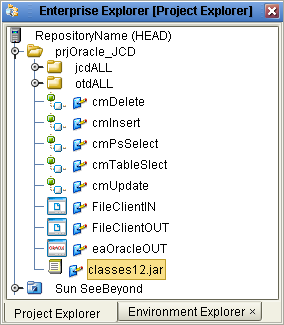
The Add/Remove Jar Files window appears.

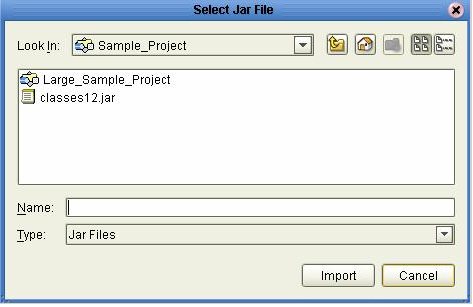
The Class Browser dialog box appears.
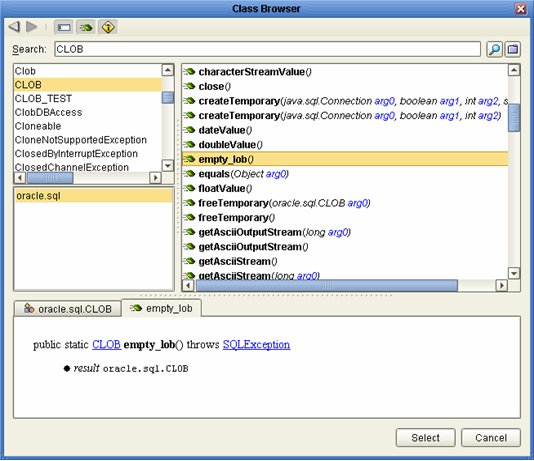
The Create Variable dialog box appears.
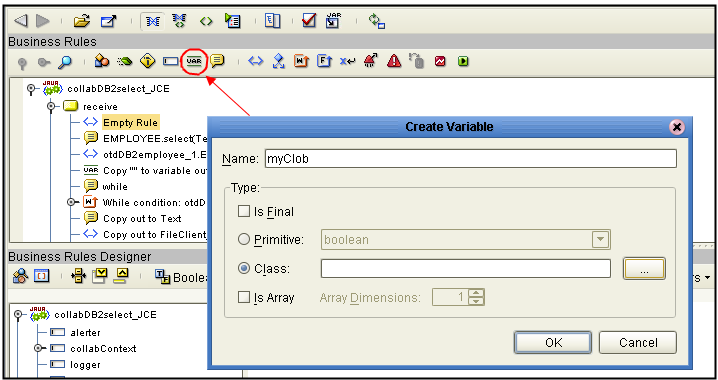

In the Java Collaboration Editor, the Java code resembles the following:
public void receive( com.stc.connector.appconn.file.FileTextMessage input,cLOB.
CLOBOTD CLOB_1 ) throws Throwable
{
//@map:CLOB_1.getCLOB_TEST.insert
CLOB_1.getCLOB_TEST().insert();
//@map:Copy java.math.BigDecimal.valueOf(100) to CUSTOMER_ID
CLOB_1.getCLOB_TEST().setCUSTOMER_ID( java.math.BigDecimal.
valueOf( 100 ) );
//@map:Copy oracle.sql.CLOB.empty_lob to PROCESSED_TEXT
CLOB_1.getCLOB_TEST().setPROCESSED_TEXT( oracle.sql.CLOB.empty_lob() );
//@map:CLOB_TEST.insertRow
CLOB_1.getCLOB_TEST().insertRow();
//@map:CLOB_1.getCLOB_TEST.select("customer_id = 100 for update")
CLOB_1.getCLOB_TEST().select( "customer_id = 100 for update" );
//If
if (CLOB_1.getCLOB_TEST().next()) {
//@map:oracle.sql.CLOB myClob;
oracle.sql.CLOB myClob;
//@map:Copy cast PROCESSED_TEXT to oracle.sql.CLOB to myClob
myClob = (oracle.sql.CLOB) CLOB_1.getCLOB_TEST().getPROCESSED_TEXT();
//@map:myClob.putString(1,Text)
myClob.putString( 1,input.getText() );
//@map:CLOB_TEST.updateRow
CLOB_1.getCLOB_TEST().updateRow();
}
}